Room and Gardens – Stylish Ideas for Room & Garden Decor
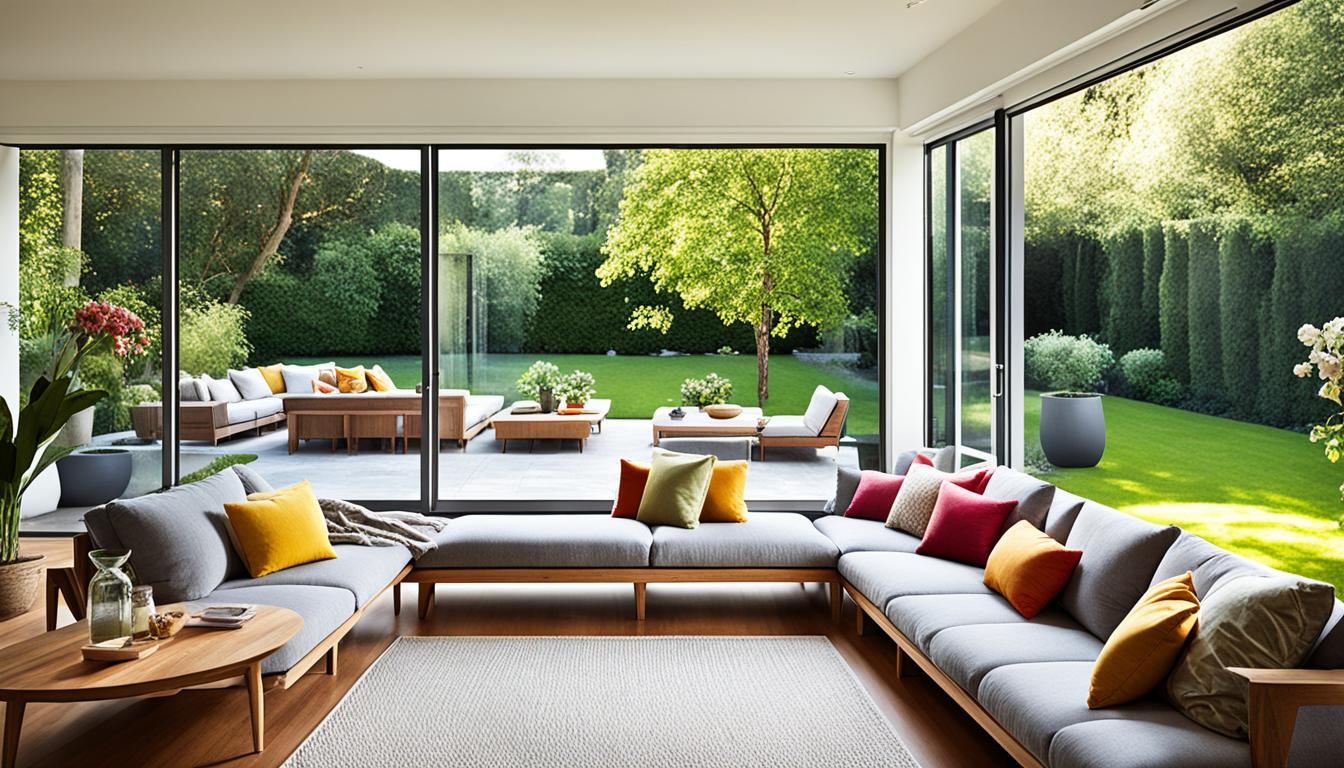
I’m always searching for ways to make my living space look great and feel connected. This guide will show you how to mix your room and garden decor smoothly. You’ll learn to create a smooth transition between indoors and outdoors. Plus, you’ll see how to add nature touches and make your garden sustainable.
Let’s start making your home and garden look amazing together. We’ll make sure everything works well together and looks beautiful.
Key Takeaways
- Discover ways to seamlessly blend indoor and outdoor living spaces for a cohesive aesthetic
- Learn how to maximize natural light and airflow for a more inviting and energy-efficient home
- Explore nature-inspired elements and organic textures to create a harmonious interior design scheme
- Uncover sustainable landscaping and functional garden features to transform your outdoor oasis
- Embrace biophilic design principles and eco-friendly practices for a healthier, more sustainable living environment
Blending Indoor and Outdoor Living Spaces
Making a smooth transition between indoor and outdoor living areas is crucial for a cohesive look. By combining indoor-outdoor living, you can make your room and garden feel connected. This creates a sense of openness and unity.
Seamless Transitions from House to Garden
Big windows, sliding glass doors, and smart entryways help create a smooth seamless transition from inside to outside. Using similar materials and textures inside and out makes the flow between areas better.
Maximizing Natural Light and Airflow
Getting the right amount of natural light and airflow is key for a peaceful open concept design. Skylights, clerestory windows, and well-placed doors bring in light and air. This makes your home bright and refreshing.
“Blending indoor and outdoor living is all about creating a sense of fluidity and connectivity, where the boundaries between the two become almost indistinguishable.”
With careful design, you can easily move from your home to your garden. This brings you closer to nature and improves your living experience.
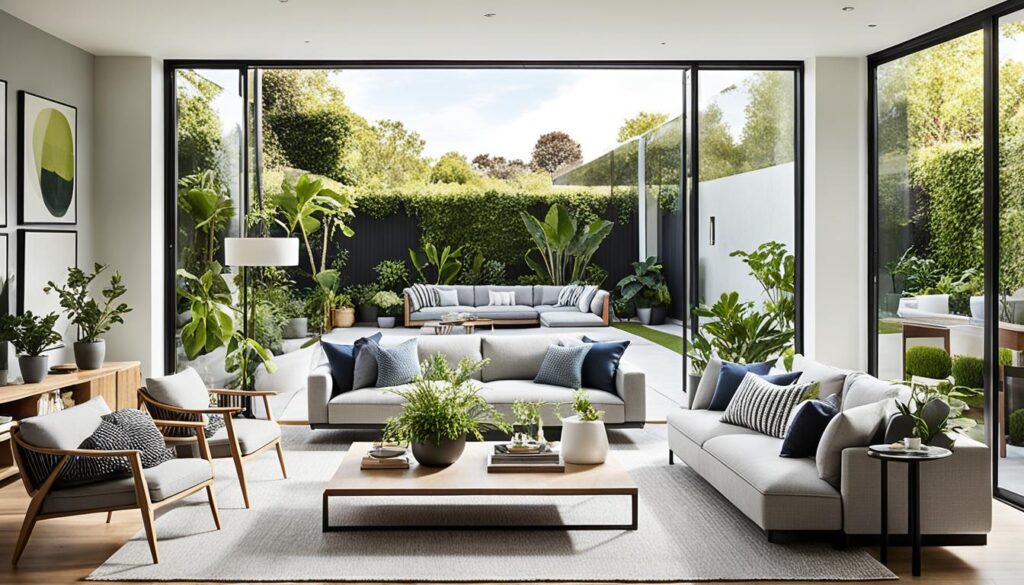
Creating a Harmonious Interior Design Scheme
Designing a cohesive and visually striking interior space means finding the right balance between indoor and outdoor areas. By picking complementary color schemes, textures, and materials, you can merge your room and garden décor. This creates a harmonious and welcoming atmosphere in your home.
Choosing a color palette that matches both your indoor and outdoor spaces is key. Go for colors that match the garden’s natural tones, like earthy browns, soothing greens, and calming blues. This creates a sense of continuity and visual unity between your rooms and the garden.
Using natural textures and materials helps tie your interior design to your garden. Think about adding wood, stone, or rattan accents that mirror your garden’s organic feel. Or, use botanical-inspired patterns and prints for a unified look.
| Indoor Design Element | Corresponding Outdoor Element |
|---|---|
| Earthy Color Palette | Complementary Garden Hues |
| Natural Textures (wood, stone, rattan) | Organic Outdoor Materials |
| Botanical Patterns and Prints | Garden-Inspired Motifs |
By blending these design elements, you can make a smooth transition between your indoor and outdoor spaces. This lets the natural beauty of your garden flow into your home and vice versa.
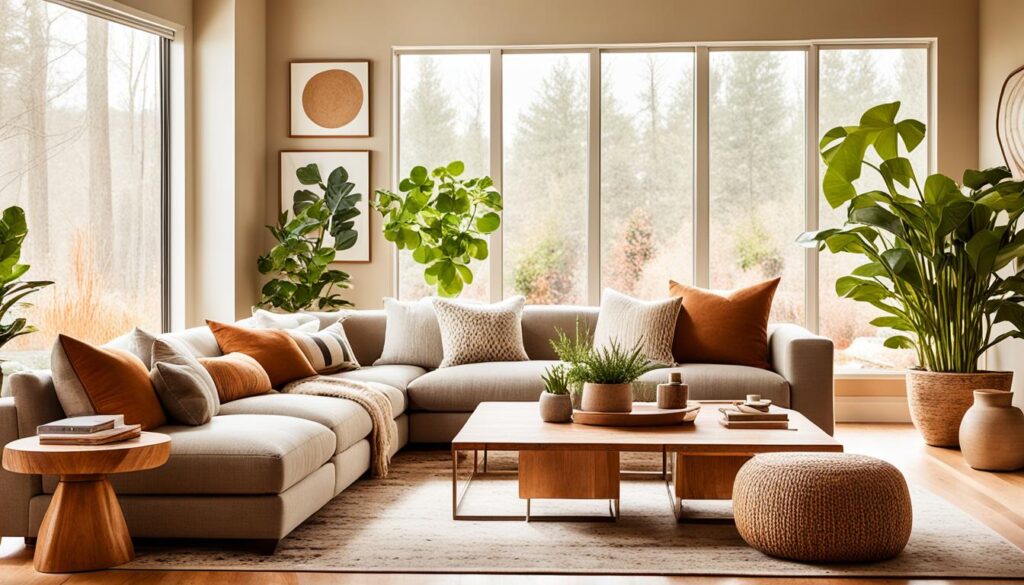
“The key to harmonious interior design is to find the perfect balance between the indoors and outdoors, using color, texture, and natural materials to create a cohesive and inviting aesthetic.”
Incorporating Nature into Your Room Decor
Bringing nature into your home can change how you feel. By adding nature-inspired elements, you make your space calm and peaceful. Let’s see how to mix the outdoors with your indoor style using organic textures and natural materials.
Bringing the Outdoors In with Greenery
Adding indoor plants is a simple way to make your room feel like a garden. Choose plants that fit your room’s light and arrange them nicely. This makes your space look beautiful and relaxing.
Organic Textures and Natural Materials
You can also add nature to your room with organic textures and natural materials. Use woven baskets, jute rugs, or a wooden table for a cozy feel. Add stone or ceramic vases and natural fiber hangings for a calming look.
With these nature-inspired touches, your room becomes a peaceful retreat. It feels connected to the outdoors, making your living space more serene.
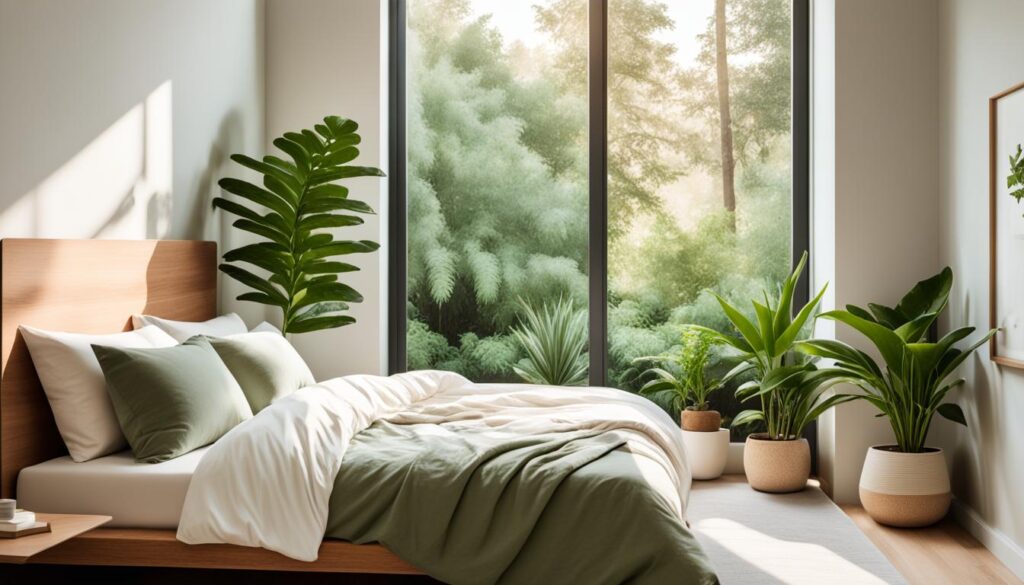
room and gardens
Combining room and garden design creates perfect living spaces. It blends interior design and landscape architecture for a look that’s both beautiful and functional. This approach makes spaces that work well together.
Choosing colors, textures, and materials that match is key. Using natural stone or wood inside and outside helps create a unified look. This makes the room and garden feel connected.
It’s also important to make moving from indoors to outdoors easy. Windows, sliding doors, or retractable walls help with this. They let people move easily between the room and garden, making the space feel bigger.
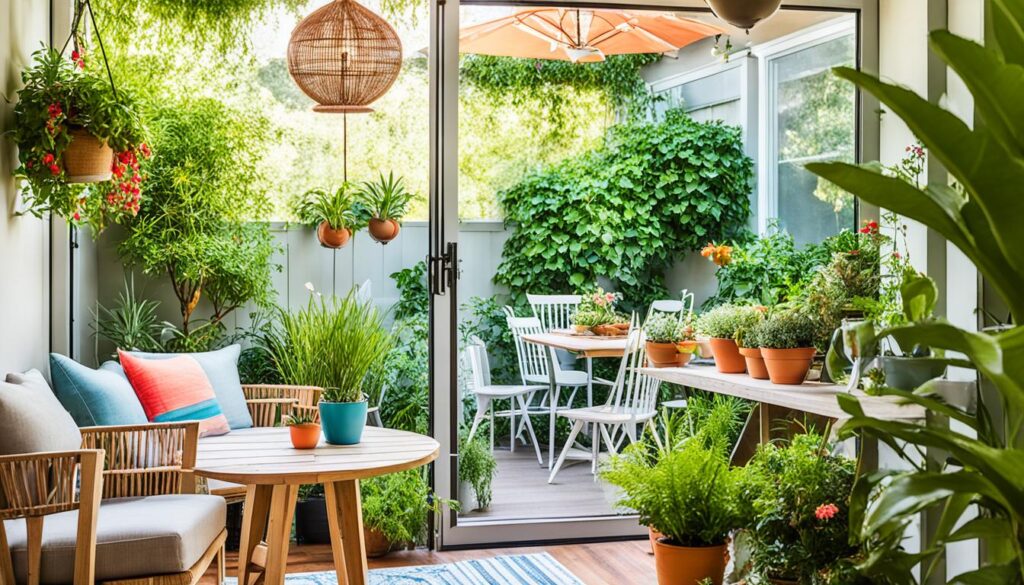
Letting in natural light and air is another way to connect the room and garden. Windows and openings let in sunlight and a breeze. This makes the space feel more open and connected.
“The ultimate goal in harmonizing room and garden design is to craft a living environment that feels effortlessly connected, where the boundaries between the indoors and outdoors become almost imperceptible.”
Using smooth transitions, matching design, and nature makes the room and gardens experience special. It brings a sense of peace and connection to the outdoors.
Designing Your Dream Outdoor Oasis
Turning your outdoor areas into a beautiful oasis takes careful planning and design. Use sustainable landscaping and add garden features that are both useful and pretty. This way, you get a peaceful outdoor space that feels like part of your home.
Embracing Sustainable Landscaping
Sustainable landscaping is good for the planet and makes your outdoor areas look better for longer. Use plants that are native to your area because they need less water and care. Add plants that can survive with little water and use systems that save water to help the environment.
Functional and Aesthetic Garden Features
When making your outdoor oasis, mix useful and pretty elements. Add comfy seating like outdoor sofas or cozy chairs for relaxing and having fun. Put in a water feature, like a fountain or pond, for the calming sounds of nature. Use lots of plants with bright flowers and greenery to make your space look beautiful and welcoming.
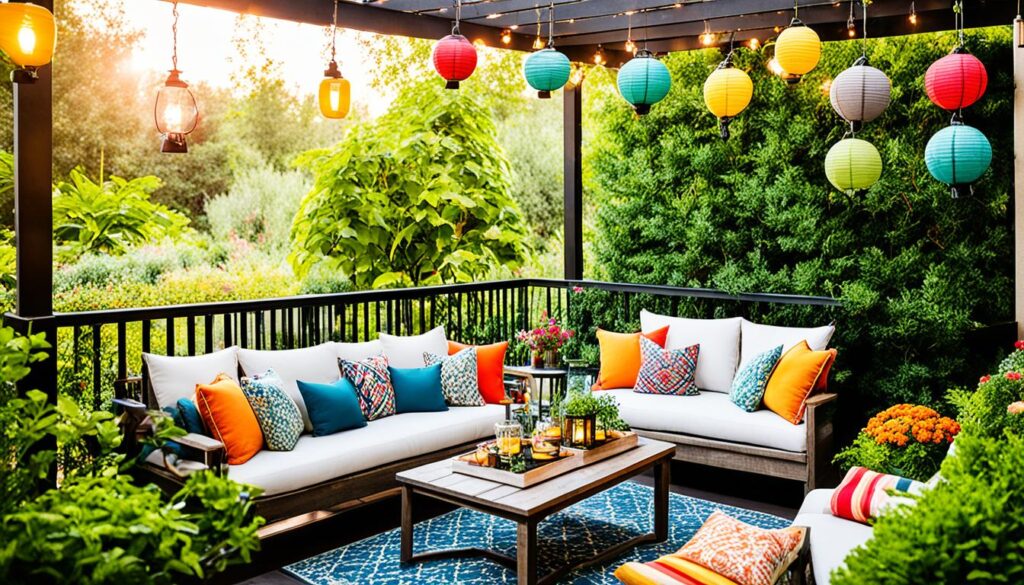
By using sustainable landscaping and designing your garden well, you can make your outdoor areas a true oasis. Here, you can enjoy nature’s beauty and the comforts of home together.
Embracing Biophilic Design Principles
Biophilic design connects humans with nature, making it a powerful way to link your room and garden. It uses natural materials, lots of greenery, and indoor-outdoor connections. This creates a space that heals the senses and soul.
Using natural materials is key in biophilic design. Wood, stone, and other earthy elements add warmth and beauty to your room. Think about adding a wooden table, a stone fireplace, or a woven light to link your indoor and outdoor areas.
Adding greenery is also crucial. Plants, vines, or a living wall make your room look better and clean the air. They help you feel closer to nature and enjoy its calming effects.
To really follow biophilic design, let in lots of natural light and air. Big windows, skylights, and sliding doors make the transition from indoors to outdoors smooth. This lets you enjoy the outdoors while staying cozy inside.
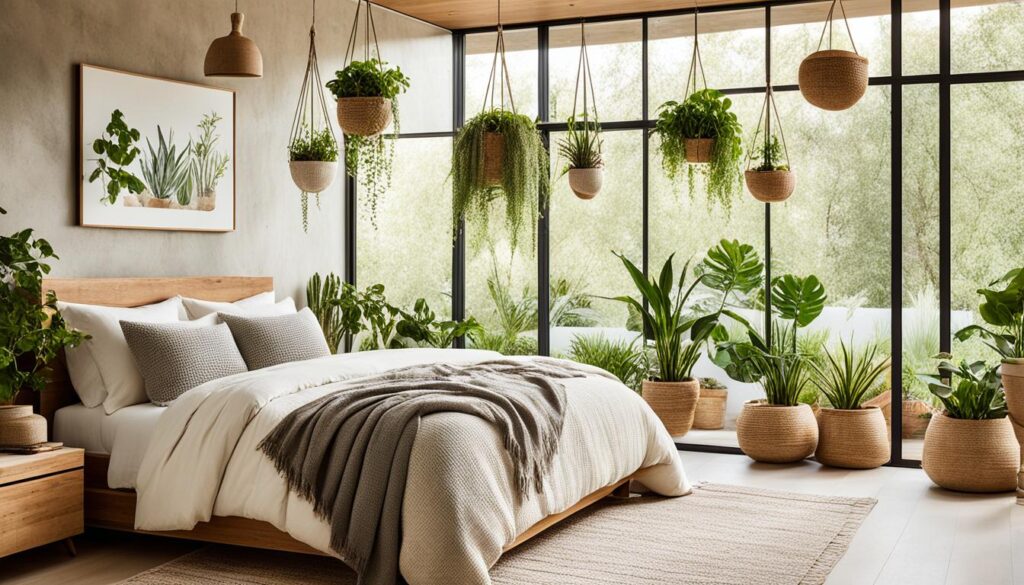
With these biophilic design ideas, you can make your space a peaceful, nature-focused haven. It will feed your senses and boost your health. Let biophilic design bring you closer to nature and happiness.
Maximizing Small Spaces for Cozy Retreats
You can make even small spaces cozy and functional. With smart tricks, you can use every inch well. This turns your small space into a warm, inviting place.
Clever Storage Solutions
Storage is crucial in small spaces. Use smart storage that fits your decor. Choose furniture like ottomans with secret spots, wall shelves, and under-bed containers. This keeps your space tidy and organized.
Versatile and Multifunctional Furniture
In small spaces, multifunctional furniture is a must. Find pieces that do more than one thing, like a daybed that’s also a sofa, or a coffee table with storage. Pick small space design items that change with your needs.
With storage solutions and multifunctional furniture, small spaces can be cozy and inviting. A bit of creativity lets your room and garden feel bigger than they are.
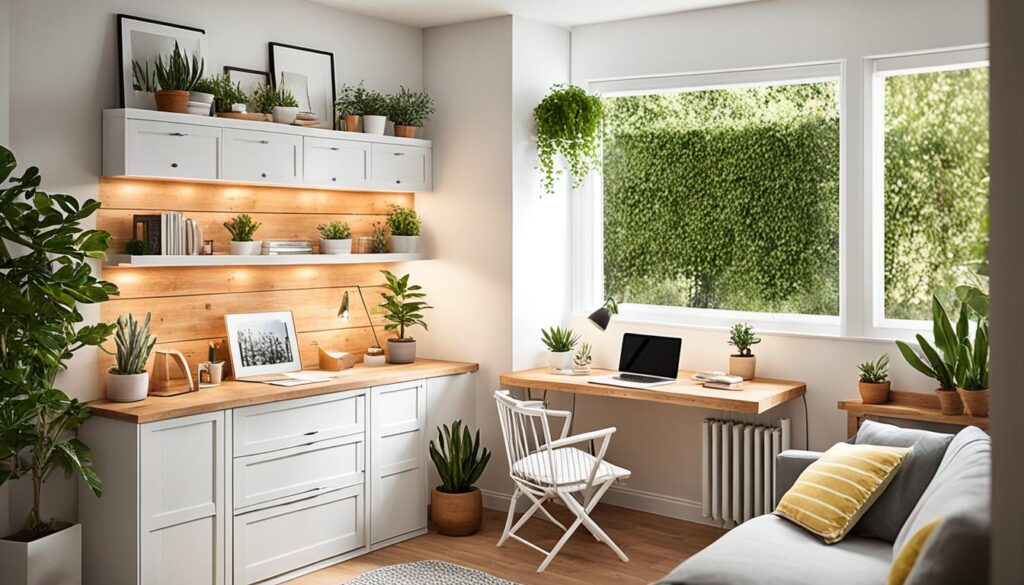
“The key to small space design is to choose furniture and decor that are multifunctional and adaptable to your needs.”
| Storage Solutions | Multifunctional Furniture |
|---|---|
|
|
Incorporating Eco-Friendly Practices
Using sustainable design and eco-friendly practices makes our rooms and gardens better for the planet. We can lessen our environmental impact by choosing sustainable materials and using less water in our gardens. This helps make our living spaces healthier and more sustainable.
Choosing eco-friendly materials is a big part of sustainable design. Options like reclaimed wood, recycled glass, and organic fabrics are both beautiful and good for the planet. These materials help us create spaces that are good for the environment and look great.
Energy-efficient solutions are also key to eco-friendly living. Using less energy means lower bills and less harm to the planet. We can do this by picking energy-saving lights, appliances, and systems. Plus, smart design choices like well-placed windows and insulation help save even more energy.
In the garden, water-wise gardening is important. Techniques like xeriscaping and using rainwater systems cut down on water use. This keeps our gardens beautiful without wasting this valuable resource.
By adopting these eco-friendly ways, we make our spaces reflect our style and help the planet. It’s a way to enjoy our surroundings and make a positive change for the environment.
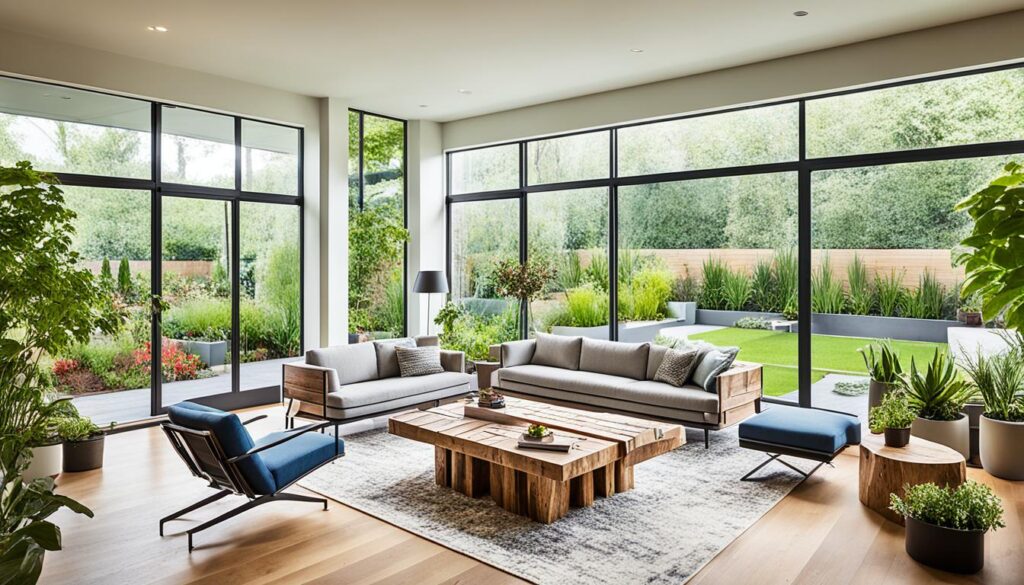
“Sustainability is no longer about doing less harm, it’s about doing more good.”
Room and Garden Decor for Entertaining
Designing your living spaces with entertaining in mind can make your home more functional and fun. It’s important to create a smooth indoor-outdoor flow. This lets guests easily move between the inside and the beautiful outdoor living areas.
To make your space welcoming, think about adding things that help people mingle and relax. Use comfy seating like plush sofas or cozy lounge chairs for intimate chats. Also, have flexible entertaining spaces like a dining table that can grow for big groups or a coffee table that serves as a buffet.
- Blend indoor and outdoor living with collapsible doors or large windows that blur the boundaries between the two spaces.
- Curate a décor scheme that seamlessly flows from one area to the next, using complementary colors, textures, and furnishings.
- Enhance the ambiance with strategic lighting, such as string lights or lanterns, to create a warm and inviting atmosphere.
By designing your room and garden for entertaining, you create a space that makes guests want to stay, chat, and enjoy themselves. This makes your home a place where memories are made.
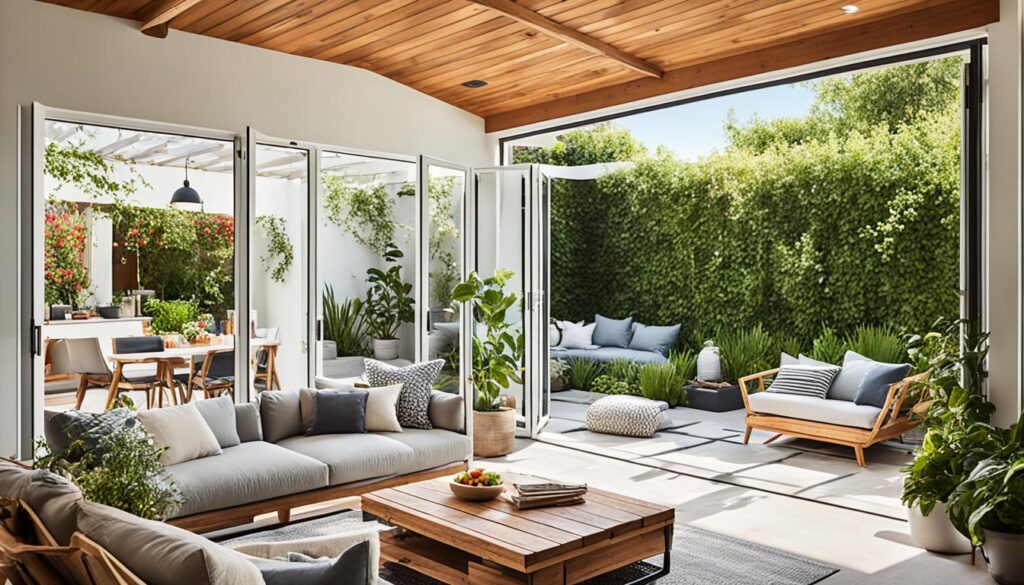
| Design Feature | Benefit for Entertaining |
|---|---|
| Flexible Seating Arrangements | Promotes intimate conversations and casual interactions |
| Collapsible Doors or Large Windows | Blends indoor and outdoor living for seamless flow |
| Complementary Décor Scheme | Creates a cohesive and visually appealing environment |
| Strategic Lighting | Enhances the ambiance and creates a warm, inviting atmosphere |
Conclusion
As we end our journey into room and garden design, I hope you’ve learned a lot. You now have tips to make your living spaces beautiful and peaceful. By using indoor-outdoor living, sustainable design, and nature in your decor, you can make a home that fits your style and needs.
We looked at how to mix indoor and outdoor areas, use natural light, and add nature to your decor. We also talked about making your interior design flow well and using biophilic design. Plus, we shared ways to make small spaces work better with smart storage and flexible furniture.
Starting your room and garden makeover, think about being eco-friendly and using materials that are good for the planet. Use the tips from this article to create a space that looks great and feels good. You’ll end up with a room and garden that shows off your style and improves your health.

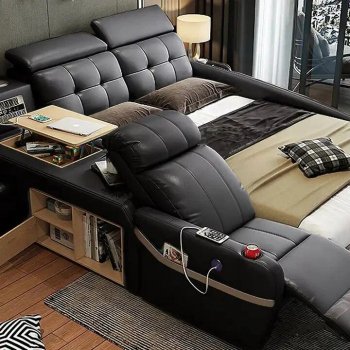
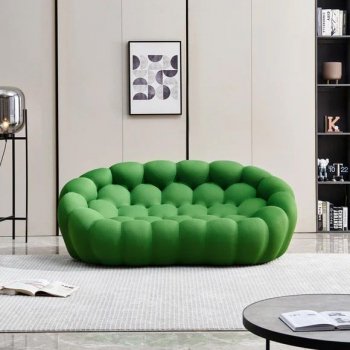
















Leave a comment